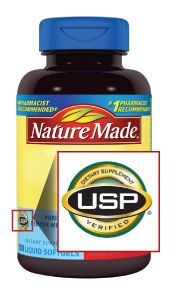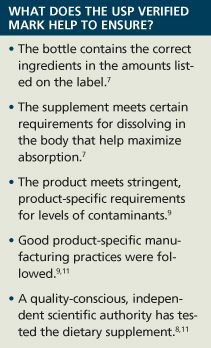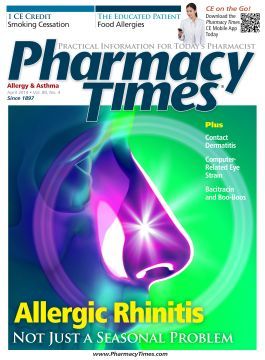Publication
Article
Pharmacy Times
Dietary Supplement Quality: The Meaning of the USP Verified Mark
This article was sponsored by Nature Made Nutritional Products.
Approximately 150 million Americans use dietary supplements annually.1 With the availability of many different brands and types of dietary supplements in stores and pharmacies, product selection can be daunting.
Pharmacists are often the health care professionals patients rely on for information on dietary supplements.
2
Recent press regarding quality and safety issues in the dietary supplement industry may lead more consumers to ask questions about quality issues related to dietary supplements, making counseling consumers more challenging.
3,4
Although pharmacists may already be familiar with the United States Pharmacopeial Convention (USP), additional knowledge of USP standards in the context of dietary supplements may help pharmacists be more confident in making recommendations regarding these products.

FDA Regulations and USP
In 2007, the FDA issued its final guidance on Current Good Manufacturing Practices (cGMPs) for dietary supplements.1 Under the cGMPs, manufacturers are required to establish their own quality standards for manufacturing processes, packaging, storage, and ingredient testing, and must properly document that these standards are being met. For example, the cGMPs stipulate that manufacturers must take all necessary precautions to prevent contamination. Manufacturers are also required to verify that their laboratory examination and testing methodologies are appropriate.5 Although the cGMP provides a framework for what constitutes compliance under these regulations, the FDA does not test the products or provide the specific definitions of what is considered appropriate for a given product or process.5,6

Some manufacturers have taken steps to meet more stringent standards than what is required by the FDA cGMPs by voluntarily submitting to rigorous testing by a third-party scientific authority, such as USP.7,8 USP is a globally recognized, nongovernmental, nonprofit organization that sets standards for identity, strength, quality, and purity of medicines, food ingredients, and dietary supplements. Some USP standards have been incorporated in FDA regulations.7-10
The USP Verified Mark
USP is often associated with pharmaceutical products and ingredients. There may be less awareness among pharmacists and consumers with regard to USP’s quality standards for dietary supplements and the robustness of the USP Dietary Supplement Verification Program (“DSVP”) that stands behind those standards. Dietary supplement products are awarded use of the “USP Verified” Mark on their label to indicate that, in addition to meeting FDA requirements, they have met USP’s own product-specific standards.7,11
Before a dietary supplement is accepted into the DSVP, the USP staff, in consultation with the appropriate USP expert committee, evaluates the supplement to ensure that it does not contain any ingredients with known safety concerns. This initial screening helps to ensure that supplements with known safety concerns do not become part of the DSVP.7,12 To verify the quality of dietary supplements, USP’s DSVP staff conducts extensive on-site facility GMP audits of manufacturing
operations, reviews product documentation, and tests product samples.

Unlike the FDA cGMP regulations, USP sets quality standards that are product specific.7,11 USP creates dietary supplement monographs that outline appropriate tests and analytical test methods to be used (eg, chromatography). USP dietary supplement monographs contain detailed specifications for identification, potency, and purity, and include information regarding compounds known to be harmful (eg, alkaloids or terpenes).7,13 Testing is designed to verify that dietary supplements contain the ingredients listed on the label, with the correct potency and amount of dietary ingredient, and that harmful levels of contaminants, such as heavy metals, pesticides, bacteria, and molds, are not present.7,8 The DSVP provides additional safeguards for known issues with a given dietary supplement product. For instance, the supplement ginkgo biloba often contains ginkgolic acids that are known for their potential to cause allergic reactions, as these acids are structurally similar to urushiol—the sensitizing oil present in poison ivy leaves. The USP monograph for ginkgo biloba sets stringent, specific limits to prevent consumers from exposure to potentially dangerous levels of ginkgolic acids. Dietary supplements are also tested by DSVP staff for disintegration or dissolution to help ensure that the product will break down in the body, which is necessary for proper absorption.7
The DSVP program includes annual on-site GMP audits conducted by USP scientists that check for continued compliance with both the FDA’s cGMPs and the USP’s product-specific GMPs. Finally, all dietary supplements awarded the USP Verified Mark are subject to annual post market surveillance testing.9,11
Role of the Pharmacist
Pharmacists play an important role in helping consumers select dietary supplements manufactured by reputable companies.14 There are more than 70 USP-verified dietary supplement formulas, some of which are only available online. Nature Made
®
brand vitamins, commonly available in stores, account for 47 of the USP-verified formulas.15 When consumers ask for guidance on choosing a trustworthy brand, pharmacists can feel more confident in recommending products that have the USP Verified Mark because only these products are assured to meet the USP’s stringent quality standards.7-9,11

References
- Council for Responsible Nutrition. Dietary supplements: safe, beneficial and regulated. www.crnusa.org/CRNRegQandA.html. Accessed February 2014.
- Braun LA, Tiralongo E, Wilkinson JM, et al. Perceptions, use and attitudes of pharmacy customers on complementary medicines and pharmacy practice. BMC Complement Altern Med. 2010;10:1-7.
- Newmaster SG, Grguric M, Shanmughanandhan D, Ramalingam S, Ragupathy S. DNA barcoding detects contamination and substitution in North American herbal products. BMC Med. 2013;11:1-13.
- Gavura S. Science-based medicine: new concerns about the safety and quality of herbal supplements. www.sciencebasedmedicine.org/new-concerns-about-the-safety-and-quality-of-herbal-supplements/. Accessed February 2014.
- Title 21: Food and Drugs. Code of Federal Regulations. 2011;2(111):1-39.
- Richter SG. Dietary supplements—a new paradigm for manufacturers [white paper]. Microtest Laboratories, Inc; 2010.
- Srinivasan VS. Challenges and scientific issues in the standardization of botanicals and their preparations: United States Pharmacopeia’s dietary supplement verification program--a public health program. Life Sci. 2006;78(18):2039-2043.
- 2013 Annual Report. United States Pharmacopeial Convention website. www.usp.org/sites/default/files/usp_pdf/EN/aboutUSP/usp_2013_annual-report-update.pdf. Accessed February 2014.
- Rapaka RS, Coates PM. Dietary supplements and related products: a brief summary. Life Sci. 2006;78(18):2026-2032.
- About USP. United States Pharmacopeial Convention website. www.usp.org/about-usp. Accessed February 2014.
- The regulation of dietary supplements: a review of consumer safeguards. 109th Congress, Second Session. www.gpo.gov/fdsys/pkg/CHRG-109hhrg27187/pdf/CHRG-109hhrg27187.pdf. Accessed February 2014.
- Gardiner P, Sarma DN, Low Dog T, et al. The state of dietary supplement adverse event reporting in the United States. Pharmaπcoepidemiol Drug Saf. 2008;17(10):962-970.
- Schiff PL Jr, Srinivasan VS, Giancaspro GI, Roll DB, Salguero J, Sharaf MH. The development of USP botanical dietary supplement monographs, 1995-2005. J Nat Prod. 2006;69(3):464-472.
- Kroll DJ. ASHP statement on the use of dietary supplements. Am J Health Syst Pharm. 2004;61(16):1707-1711.
- USP Verified Dietary Supplements. United States Pharmacopeial Convention website. www.usp.org/usp-verification-services/usp-verified-dietary-supplements/verified-supplements. Accessed February 2014.








